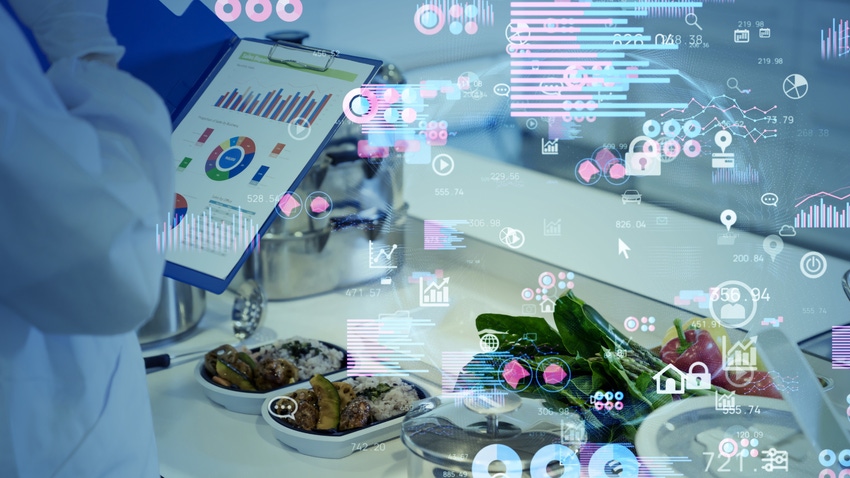AI in the Advancement of Precision Nutrition
A personal essay from a registered associate nutritionist whose area of expertise is on the effect of gene-diet interactions on health and disease
October 20, 2023

Lifestyle-mediated chronic conditions, such as heart disease, cancer, obesity and diabetes, account for 74% of annual deaths globally. These conditions are multifaceted in their origins, arising from the complex interactions between environment (diet, lifestyle) and multi-omics profile (genome, epigenome, microbiome, proteome and metabolome). The complex nature of these conditions poses difficulty in their research, prevention, management and treatment.
Individuals' unique multi-omics profile alters their response to dietary intake. This has led to the emergence of ‘precision nutrition,’ which considers the interactions between diet and multi-omics profiles to provide nutritional advice personalized to each individual, using AI.
Data analysis
Traditional statistical approaches are adequate for analyzing single biomarkers but cannot effectively analyze the interactions between diet and multi-omics data. Hence the requirement for machine learning algorithms to analyze and interpret the data.
Machine learning enables data mining, sample clustering, identification of complex patterns and classification of multi-omics data and dietary assessments.
Supervised machine learning algorithms, such as OPLS-DA and PLS-DA are the most popular approaches to multi-omics research as they are ideal for predicting response to dietary intake. Features with the known greatest impact on the prediction output are analyzed by the algorithm to create a prediction model.
Unsupervised machine learning algorithms, such as PCoA and PCA, are suited to exploratory analysis as they can identify patterns in the data and can effectively stratify populations into subtypes. Semi-supervised algorithms can improve classification with partially labelled data.
The ability of machine learning to analyze the complex interactions between multi-omics data and nutritional intake makes it a valuable tool in the advancement of precision nutrition research.
Dietary assessment
Obtaining accurate dietary intakes poses a barrier to nutrition research and healthcare. Traditional dietary assessment methods rely on self-reporting, leading to under- and over-reporting.
Image-recognition AI could overcome these problems. Smartphone apps have been developed to identify foods and use food databases and barcode scanning to calculate nutritional content.
Computational models using deep neural networks can learn to identify relevant features from input images by classifying each pixel. Models can learn to segment out different foods in an image by grouping similar pixies. Hence deep learning models have the potential to recognize unlimited food and drink items and determine volume.
Accurately identifying foods and drinks is challenging for AI, as the appearance of food changes during preparation and cooking, multiple foods can be combined, and different foods and drinks can appear similar, resulting in low classification accuracy. Even when the correct food and drinks are identified, the nutritional content of food can be altered by cooking and this needs to be reflected in the databases used by AI.
Deep learning food image recognition models have been typically trained using images of signal food items or fake food images. Accuracy is reduced when determining real-world food images with higher variance. Volume estimation can be improved by providing multiple images of food from different angles to enable 3D image construction. Future image recognition models need to be trained with real-world food images and food databases from global cuisines to improve accuracy.
Wearables
Apps and commercially available biometric sensors, known as wearable devices like smartwatches, not only record dietary intake but also track and monitor body composition, physical activity, blood pressure and blood glucose levels in real-time.
Accuracy of measurements can vary between devices and between markers being measured. Step count is most accurate in the Fitbit Charge and heart rate is most accurate in the Apple Watch and the measurement of energy expenditure was least accurate across multiple devices. There is a need for validated wearable devices to ensure the accuracy of nutrition research and disease monitoring.
With the use of AI, wearables can non-invasively monitor blood glucose and HbA1c. Glucose variability and HbA1c correlate with changes in autonomic nervous system activity, wearables can measure these changes via accelerometry, heart rate, electrodermal activity and temperature. Researchers inputted these features into random forest models and tuned using leave-one-person-out cross-validation. Root mean squared error and mean average per cent error were used to measure model accuracy. This determined that the models had a high level of accuracy for predicting glucose variability and HbA1c, with the HbA1c prediction model being as accurate as continuous glucose monitoring devices.
These AI models allow for the detection of prediabetes and early preventative intervention and for diabetics to monitor their glucose levels and HbA1c without the need for invasive continuous glucose monitoring and clinical blood tests.
Personalized recommendations
There are commercially available omics testing companies that will test consumers' genetics, epigenetics or microbiome. Based on these tests consumers are offered personalized dietary and exercise recommendations and customized supplements. Some companies have employed algorithms to synergize results from multiple data points into clear recommendations and disease risk scores.
Algorithms have been developed that can predict the optimal nutritional recommendations for an individual, such as the algorithm developed to predict post-meal glucose response based on subjects’ nutritional intake, activity levels, blood biomarkers and gut microbiome. These features were used in a gradient-boosting regression model consisting of thousands of decision trees which were inferred sequentially. The algorithm was assessed firstly by leave-one-out cross-validation and then tested on a separate cohort. The algorithm had higher accuracy in predicting which meals would produce low or high increases in glucose levels compared to a clinical dietitian. This demonstrates the potential of AI in precision nutrition as an effective method of disease management and prevention.
Precautions
The commercial precision nutrition market currently lacks regulation for data transparency and for upholding scientific rigor in the products and services offered. The demand for precision nutrition is growing faster than the scientific evidence base, leading to unsubstantiated claims based on association studies that lack clinical relevance and actionable advice.
Algorithms with limited predictive power are being implemented and are trained on consumers through use. This is putting the advancement of the industry at the expense of consumers who may be receiving ineffective recommendations.
There is a lack of research on diverse populations, applying the same algorithms developed using one population to another population will reduce accuracy and lead to inappropriate recommendations.
Repeated omics testing is expensive and time-consuming which prevents much of the population from accessing commercially available tests and hinders the implementation of precision nutrition into healthcare.
Future of precision nutrition
The future of precision nutrition requires the implementation of regulations and guidelines for research, industry and health care. Industry standards of scientific rigor will protect the public from unvalidated recommendations and ensure data protection.
Future research needs to focus on the validation and standardization of biomarkers within diverse populations. Further development of AI models will lead to the analysis of increasingly complex data sets and more precise recommendations.
The integration of precision nutrition approaches into health care can shift the focus from management and treatment towards prevention, which could lead to a reduction of disease and improved population health outcomes. Nutritional recommendations need to incorporate individuals' food preferences and cultural and social circumstances to provide a holistic approach.
Current precision nutrition approaches stratify individuals based on similarities in biomarkers and genetic variants. The concept of digital twins involves complete personalization based solely on a single individual. An individual is deeply phenotyped to produce a high-resolution model, which can be subjected to unlimited nutritional interventions to determine dietary effects for optimal health outcomes. The creation of digital twin models requires the combination of quantum and conventional processing to analyze the highly complex datasets of multiple interacting variables. This exceeds exciting computer capabilities but could be feasible in five to 10 years.
AI brings many benefits to the advancement and implementation of precision nutrition. AI can improve data collection in research and enable large multi-omics data sets to be analyzed. AI offers a holistic approach to identifying risk, diagnosis, management and prevention of disease. AI can empower individuals to take control of their health and provide personalized nutritional recommendations to optimize health. There is a need for greater regulation of commercially available wearables and direct-to-consumer testing companies to ensure consumers are receiving validated and scientifically backed information.
Read more about:
Health careAbout the Author(s)
You May Also Like


.jpg?width=700&auto=webp&quality=80&disable=upscale)
.jpg?width=700&auto=webp&quality=80&disable=upscale)

.jpg?width=300&auto=webp&quality=80&disable=upscale)
.jpg?width=300&auto=webp&quality=80&disable=upscale)
.jpg?width=300&auto=webp&quality=80&disable=upscale)
.jpg?width=300&auto=webp&quality=80&disable=upscale)
.jpg?width=300&auto=webp&quality=80&disable=upscale)